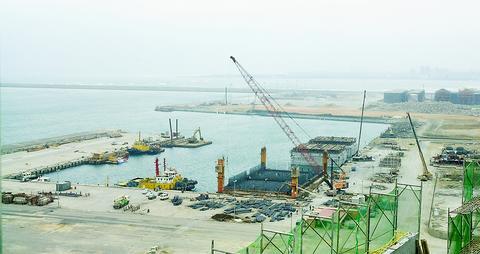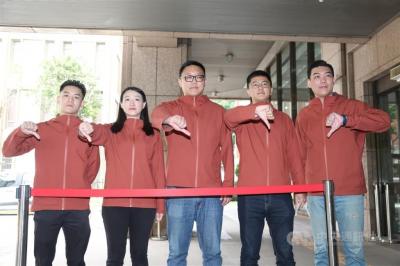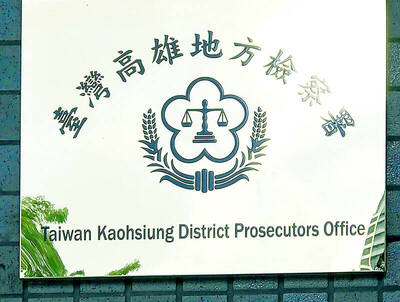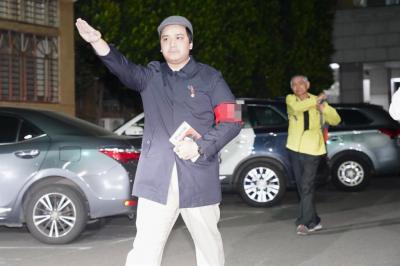Keelung's dominance as the gateway for Taiwanese exports and foreign imports in the north of the country is set to be challenged by the Port of Taipei, which is undergoing a make-over to become an international container terminal that will double the north's cargo capacity.
The Taipei port runs along the south bank of the Tamsui River between Pali and Linkou townships. The port was officially upgraded last week to become Taiwan's seventh international port, joining Keelung, Taichung, Kaohsiung and Hualien, as well as the auxiliary ports of Suao in Ilan County and Anping in Tainan City.
While the Executive Yuan had nominally agreed to make Taipei Port an international auxiliary port of Keelung port in 1997, the Cabinet had held back on officially upgrading the port until breakwaters had been completed and the facilities had been inspected to confirm they met international standards at the end of last year.

PHOTO: GEORGE TSORNG, TAIPEI TIMES
Construction on the port began in 1993 and limited operations began in July 1997.
Until last year, the port's wharfs were only intended to accommodate bulk cargo which was not transported in containers.
The port has three bulk cargo wharfs, with two sandstone wharfs and one oil wharf. Another six bulk cargo wharfs are set to go into operation in June.
In August 1993, the port signed a contract to significantly increase the capabilities of its facilities. Shipping giants Evergreen Marine, Yangming Marine and Wan Hai Lines together formed a venture to invest in the construction of seven container terminals, a warehouse and shore protection work.
The seven container terminals would allow ocean container vessels to discharge and load goods in containers, standard metal transport boxes usually measuring 20 feet in length. Cargo is usually measured in 20-foot equivalent units (TEU). The container terminals will be equipped with facilities such as cranes to accommodate the container vessels.
According to the contract, the first container terminal will be ready for operation by 2008 and the other six by 2014 at the latest.
Plans for Taipei port will have a significant effect on Keelung port, which lies just 63km away and is the main port servicing northern Taiwan.
"In the past, about 1 million to 1.4 million TEUs of cargo with the final destination of northern Tai-wan were unloaded at Kaohsiung port because Keelung Port was unable to accommodate all the traffic," said a Taipei port official, who would only identify himself by his surname, Wei.
Wei estimated that each new container terminal at Taipei port would be able to accommodate at least 300,000 TEUs of cargo a year.
He pointed out that upon completion of all seven container terminals, Taipei port would be able to accommodate significantly more than the 1.4 million TEUs of north-bound cargo that were currently being shipped through Kaohsiung port.
Given Taipei port's new facilities, it could possibly take over some of the 1.9 million TEUs now shipped through Keelung.
By 2014, Taipei port expects to handle upwards of 2 million TEUs.
"While Taipei port's cargo traffic last year measured around 5.4 million tonnes of bulk cargo, we expect to hit 10 million tonnes with the new container terminal in 2008," Wei said.
Keelung Harbor Bureau director Wang Chung-hsiung (
"In the future, Taipei port will most likely service larger vessels from the US or Europe while Keelung port will service smaller vessels from countries closer to Taiwan," Wang said.
However, the Keelung Harbor Bureau said that already the amount of sandstone shipped through Kee-lung has declined since Taipei port began servicing vessels carrying sandstone.
Taipei port's upgrade to international status would enable shipping companies to berth and discharge cargo at Taipei port directly, bypassing previous applications at the Keelung Port administration.
"It's hard to predict how the port's traffic will be affected because the traffic each port receives will be mostly up to the shipping companies to decide. It will depend on which companies each port can attract," Wang said.
Wei said that Taipei port had many advantages over Keelung's.
"Taipei is a metropolitan city and is the location of a large number of businesses, so most cargo is bound for the city," Wei said.
"Taipei port is strategically located to allow traders to bypass land shipping because it is so close to the city," Wei said.
In addition, the port also has aspirations as a tourism center.
Taipei port director Wu Fu-hsiung (
"We hope to set up a tourism area. "People would be able to experience berthing at the port and visit the port to see the port's operations," Wu said.
Wu joked that given the amount of construction at the port, tourism projects probably would not materialize until after 2011.

Taiwan is stepping up plans to create self-sufficient supply chains for combat drones and increase foreign orders from the US to counter China’s numerical superiority, a defense official said on Saturday. Commenting on condition of anonymity, the official said the nation’s armed forces are in agreement with US Admiral Samuel Paparo’s assessment that Taiwan’s military must be prepared to turn the nation’s waters into a “hellscape” for the Chinese People’s Liberation Army (PLA). Paparo, the commander of the US Indo-Pacific Command, reiterated the concept during a Congressional hearing in Washington on Wednesday. He first coined the term in a security conference last

Prosecutors today declined to say who was questioned regarding alleged forgery on petitions to recall Democratic Progressive Party (DPP) legislators, after Chinese-language media earlier reported that members of the Chinese Nationalist Party (KMT) Youth League were brought in for questioning. The Ministry of Justice Investigation Bureau confirmed that two people had been questioned, but did not disclose any further information about the ongoing investigation. KMT Youth League members Lee Hsiao-liang (李孝亮) and Liu Szu-yin (劉思吟) — who are leading the effort to recall DPP caucus chief executive Rosalia Wu (吳思瑤) and Legislator Wu Pei-yi (吳沛憶) — both posted on Facebook saying: “I

A court has approved Kaohsiung prosecutors’ request that two people working for Democratic Progressive Party (DPP) Legislator Lin Dai-hua (林岱樺) be detained, as a probe into two cases allegedly involving her continues. The request was made on Friday, after prosecutors raided Lin’s two offices and the staffers’ residences, and questioned five on suspicion of contravening the Anti-Corruption Act (貪汙治罪條例). The people included the directors of Lin’s Daliao (大寮) and Linyuan (林園) district offices in Kaohsiung, surnamed Chou (周) and Lin (林) respectively, as well as three other staffers. The prosecutors’ move came after they interrogated Lin Dai-hua on Wednesday. She appeared solemn following

Sung Chien-liang (宋建樑), who led efforts to recall Democratic Progressive Party (DPP) Legislator Lee Kun-cheng (李坤城), was released on bail of NT$80,000 today amid outcry over his decision to wear a Nazi armband to questioning the night before. Sung arrived at the New Taipei District Prosecutors’ Office for questioning in a recall petition forgery case last night wearing a red armband bearing a swastika, carrying a copy of Adolf Hitler’s Mein Kampf and giving a Nazi salute. Sung left the building at 1:15am without the armband and covering the book with his coat. Lee said today that this is a serious